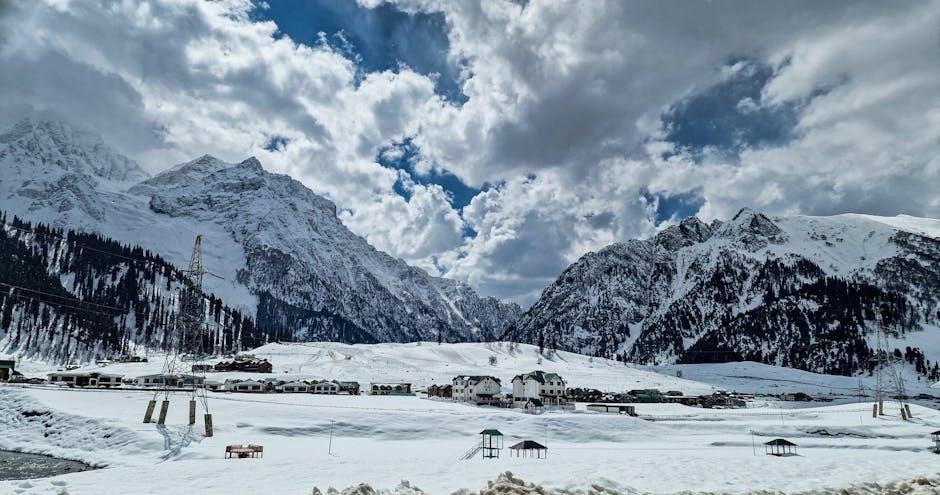Mountains hold profound biblical significance, appearing over 500 times as symbols of divine connection and spiritual encounters. They are central to worship, covenants, and revelation, bridging heaven and earth.

Overview of Mountains in the Bible
Mountains are prominent features in the Bible, mentioned over 500 times, serving as both physical landscapes and symbolic elements. They often represent divine encounters, worship, and covenant-making. Many key events unfold on mountains, such as revelations, sacrifices, and significant promises. From Mount Ararat, where Noah’s ark rested, to Mount Zion, a symbol of God’s presence, these locations are central to biblical narratives. Mountains also symbolize strength, refuge, and spiritual elevation, reflecting humanity’s connection to God. Their elevated status made them ideal for sacred activities, emphasizing their role as bridges between heaven and earth. The Bible highlights 12 key mountains, each holding unique historical and spiritual significance, shaping the faith and identity of God’s people. These mountains are not just geographical markers but also spiritual milestones in the story of redemption and divine interaction with humanity.
Symbolic and Spiritual Meaning of Mountains
Mountains in the Bible are rich with symbolic and spiritual significance, often representing divine presence, strength, and refuge. They are seen as bridges between heaven and earth, where God reveals Himself to humanity. The elevated nature of mountains symbolizes closeness to God, who is believed to dwell in the heavens. Many mountains serve as sites for pivotal spiritual events, such as covenant-making, worship, and divine revelations. For instance, Mount Sinai is where God gave the Ten Commandments, while Mount Zion symbolizes God’s eternal presence and kingdom. Mountains also embody enduring strength and stability, reflecting God’s unchanging nature. Additionally, they represent spiritual ascent and the journey toward holiness, inviting believers to seek a deeper connection with God. Their prominence in scripture underscores their role as sacred spaces where humanity encounters the divine, making them central to biblical faith and spirituality.
The 12 Key Mountains in the Bible
The Bible highlights 12 pivotal mountains central to its narrative, each holding unique historical and spiritual significance. These mountains served as sites for divine revelations, covenants, and pivotal events, shaping the story of faith and God’s connection with humanity.
Mount Ararat (Genesis 8:4)

Mount Ararat is famously known as the resting place of Noah’s Ark after the great flood, as recorded in Genesis 8:4. The Bible refers to the “mountains of Ararat,” though this plural form likely indicates a single mountain with two distinct peaks. The higher peak is traditionally believed to be where the ark came to rest. This event symbolizes God’s mercy and the renewal of life after judgment. Mount Ararat holds significant symbolic value, representing divine deliverance and a new beginning. Its prominence in biblical history underscores its role as a physical and spiritual landmark, connecting humanity to God’s covenant promises. The mountain’s enduring legacy continues to inspire faith and reflection on God’s faithfulness and redemption.
Mount Abarim (Numbers 33:47-48)

Mount Abarim is a significant biblical location mentioned in Numbers 33:47-48, where it is associated with the Israelites’ journey during their wilderness wanderings. Situated near Mount Nebo, it is the place from which Moses viewed the Promised Land before his death. The mountain holds both geographical and spiritual importance, as it marks a pivotal moment in Israel’s history. Its name, meaning “beyond” or “across,” reflects its role as a boundary between the wilderness and the land of Canaan. Mount Abarim also symbolizes transition and divine promise, as it was from this vantage point that Moses glimpsed the future of God’s people. The mountain’s prominence in biblical narrative underscores its connection to leadership, vision, and the fulfillment of God’s covenant with Israel.

Mount Amalek (Judges 12:15)
Mount Amalek is a biblical site mentioned in Judges 12:15, where it is linked to the judgeship of Jephthah, a leader of Israel. The mountain is located near Mizpah in the region of Gilead, making it a strategic location in the biblical landscape. Jephthah, known for his victory over the Ammonites, is said to have resided in the area surrounding Mount Amalek. This mountain holds significance as a place associated with leadership and divine deliverance, reflecting the broader theme of God’s intervention in Israel’s history. Its mention in Judges underscores its role in the narrative of Israel’s judges, who were instrumental in guiding the nation during a period of spiritual and political turmoil. Mount Amalek thus serves as a reminder of the importance of faith and trust in God’s providence during challenging times.
Mount Bashan (Psalms 68:15)
Mount Bashan, mentioned in Psalms 68:15, is a prominent mountain in the biblical narrative, located in the region of Bashan, east of the Jordan River. Known for its lush fertility and majestic beauty, Bashan was often associated with abundance and strength. The psalm describes God’s presence on the mountain, emphasizing His power and dominion over creation. Historically, Bashan was part of the kingdom of Og, a giant and powerful ruler defeated by the Israelites during their conquest of Canaan. The mountain’s mention in Scripture highlights its symbolic role as a place of divine manifestation and judgment. Its fertile land and strategic location made it a significant area in ancient times, reflecting both natural and spiritual richness. Mount Bashan thus serves as a reminder of God’s sovereignty and the interconnectedness of nature and faith in biblical tradition.
Mount Bethel (1 Samuel 13:2)
Mount Bethel, mentioned in 1 Samuel 13:2, holds significant biblical importance as a site of worship and divine encounter. It was a key location during King Saul’s reign, where he established a military presence. The mountain’s name, meaning “House of God,” reflects its sacred status in Israelite tradition. Historically, Bethel was a pivotal site for the patriarch Jacob, who encountered God there and named it Bethel (Genesis 28:19). Its strategic location made it a center for religious and political activities. The mountain symbolizes a place of connection between heaven and earth, emphasizing God’s presence in the lives of His people. Mount Bethel’s role in both worship and warfare underscores its dual significance in the biblical narrative, serving as a reminder of faith and leadership in ancient Israel.
Mount Carmel (Joshua 15:55, 19:26, 2 Kings 19:23)
Mount Carmel, a prominent mountain in biblical history, is renowned for its strategic location and spiritual significance. It is mentioned in Joshua 15:55 and 19:26 as part of the territorial boundaries of ancient Israel. The mountain’s fame, however, is largely due to its association with the prophet Elijah, who defeated the prophets of Baal on its slopes (1 Kings 18:20-40). This dramatic event showcased God’s power and reaffirmed His covenant with Israel. In 2 Kings 19:23, Mount Carmel is referenced as a symbol of trust in God’s deliverance. Its lush vegetation and proximity to the Mediterranean made it a unique landmark, blending natural beauty with divine purpose. Mount Carmel stands as a testament to God’s intervention in human history and His desire to connect with His people through sacred spaces.
Mount Ebal (Deuteronomy 11:29, 27:13)
Mount Ebal holds significant biblical importance as a site of divine instruction and covenantal ceremony. Located in the region of Samaria, it is paired with Mount Gerizim, where the Israelites were commanded to pronounce blessings and curses upon entering the Promised Land (Deuteronomy 11:29). In Deuteronomy 27:13, the tribes of Israel gathered on Mount Ebal to declare the curses of disobedience, symbolizing their commitment to uphold God’s laws. This mountain serves as a physical and spiritual marker, reminding the people of their covenant obligations. Its rugged terrain and strategic location made it an ideal setting for such a solemn ritual. Mount Ebal’s role in biblical history underscores the importance of obedience and the consequences of turning away from God’s commandments, making it a powerful symbol of faith and accountability.
Mount Ephraim (Joshua 17:15, Judges 2:9)
Mount Ephraim is a significant biblical location, primarily associated with the tribe of Ephraim, one of the twelve tribes of Israel. In Joshua 17:15, it is mentioned as part of the territory allocated to Ephraim, highlighting its geographical importance in the early history of the Israelites. The mountain is also noted in Judges 2:9 as the burial site of Joshua, the leader who succeeded Moses and led the Israelites into the Promised Land. This connection underscores Mount Ephraim’s role as a symbol of leadership and legacy in biblical narrative. Its strategic location in the central highlands of Canaan made it a vital area for settlement and defense. The mountain’s prominence in both territorial allocation and as a resting place for a key biblical figure emphasizes its enduring significance in the story of God’s people.
Mount Gerizim (Deuteronomy 11:29, Judges 9:7)
Mount Gerizim holds a unique place in biblical history, primarily as the site where Moses instructed the Israelites to pronounce blessings upon obedience to God’s commandments. In Deuteronomy 11:29, it is paired with Mount Ebal, where curses were proclaimed, symbolizing the choice between life and death. The mountain is also notable for its role in Judges 9:7, where Jotham, the son of Gideon, delivered a parable from its summit, warning the people of Shechem about the dangers of hasty decisions and the consequences of their rebellion. Mount Gerizim’s prominence in these narratives underscores its significance as a location of divine instruction and moral reflection. Its historical and spiritual importance continues to resonate, offering timeless lessons on faith, obedience, and the consequences of human actions.
Mount Gilboa (1 Samuel 31:1)
Mount Gilboa is a significant biblical site, primarily known as the location of King Saul’s tragic demise. In 1 Samuel 31:1, it is recorded that Saul and his sons, including Jonathan, were slain by the Philistines on Mount Gilboa. This event marked the end of Saul’s reign and the transition of leadership to David. The mountain became a symbol of defeat and loss for the Israelites, as their king fell in battle. However, it also serves as a reminder of God’s sovereignty and the consequences of unfaithfulness. Mount Gilboa’s historical and spiritual significance lies in its association with the end of an era and the beginning of a new chapter in Israel’s history under David’s leadership. Its story continues to resonate as a lesson in faith, leadership, and divine providence.
Mount Moriah (Genesis 22:2)

Mount Moriah holds immense biblical significance as the site of Abraham’s ultimate test of faith. In Genesis 22:2, God instructed Abraham to offer his son Isaac as a sacrifice on this mountain. This pivotal event symbolizes unwavering trust in God’s plan and divine provision, as an angel intervened, sparing Isaac and providing a ram as a substitute. Mount Moriah is also historically linked to the Temple Mount in Jerusalem, where Solomon later built the First Temple. Its name, meaning “seen by God,” reflects its role as a place of divine encounter and sacrifice. This mountain serves as a powerful symbol of faith, obedience, and redemption, bridging the Abrahamic covenant with future worship practices in Israel. Its legacy endures as a cornerstone of biblical history and spiritual reflection.
Mount Zion (Psalm 48:1-2, Isaiah 40:9)
Mount Zion is deeply revered in the Bible as a symbol of God’s presence and divine kingship. Located in Jerusalem, it is often referred to as the City of God and the spiritual heart of Israel. Psalm 48:1-2 describes it as a place of beauty and joy, where God’s glory is evident. In Isaiah 40:9, Mount Zion is the backdrop for the proclamation of salvation, emphasizing its role in eschatological hope. Historically, it was the site of the Temple, making it central to Jewish worship and sacrifice. Mount Zion also holds prophetic significance, representing the ultimate restoration of God’s people. Its enduring legacy as a place of divine encounter and redemption continues to inspire faith and hope in both the Old and New Testaments, solidifying its importance in biblical narrative and spiritual tradition.

The Role of Mountains in Biblical Worship and Covenants

Mountains served as sacred meeting points between God and humanity, central to worship, sacrifice, and covenant establishment, symbolizing divine authority and closeness to the heavens.
Mountains as Places of Divine Revelation
Mountains in the Bible are often depicted as sites of profound divine revelation, where God communicates with humanity in extraordinary ways. From Moses receiving the Ten Commandments on Mount Sinai to Elijah encountering God in a whisper on Mount Horeb, these high places symbolize closeness to the divine. The elevation of mountains metaphorically and literally brings individuals nearer to heaven, making them ideal settings for spiritual encounters. Many key biblical events, such as the giving of the Law and prophetic visions, occur on mountains, emphasizing their role as thresholds between the earthly and heavenly realms. This physical and spiritual elevation underscores the mountains’ significance as places where God reveals His will, establishes covenants, and imparts wisdom to His people.
Mountains in the Context of Worship and Sacrifice
Mountains in the Bible frequently serve as sites for worship and sacrifice, reflecting their sacred status as meeting points between God and humanity. Elevated landscapes like Mount Moriah, where Abraham prepared to sacrifice Isaac, and Mount Carmel, where Elijah confronted the prophets of Baal, highlight their role in divine encounters. These locations were often chosen for their remoteness and elevation, symbolizing a separation from worldly distractions and a closeness to God. Sacrifices and rituals performed on mountains, such as the burnt offerings on Mount Ebal and Gerizim, emphasized obedience to God’s commands and the establishment of covenantal relationships. The physical act of ascending a mountain mirrored the spiritual ascent toward holiness, making these sites central to Israel’s worship and devotion.
Mountains and the Establishment of Covenants
Mountains played a pivotal role in the establishment of covenants within the biblical narrative, serving as sacred venues for divine promises and agreements. Mount Sinai, for instance, was the site where God delivered the Ten Commandments to Moses, forming the covenant with the Israelites. Similarly, Mount Nebo was where Moses viewed the Promised Land, symbolizing the fulfillment of God’s covenant with Abraham. Mount Zion, often associated with Jerusalem, became a symbol of God’s eternal covenant with His people. These elevated locations emphasized the transcendence and authority of God, while also underscoring the commitment required from humanity. The use of mountains in covenant-making highlighted their role as bridges between the earthly and divine realms, reinforcing the sacred nature of these agreements. This tradition continues to resonate in the spiritual and cultural identity of those who revere these biblical sites.

Historical and Cultural Context of Biblical Mountains

Biblical mountains were integral to the ancient landscape, influencing culture and spirituality. Their elevation symbolized proximity to God, making them central to worship and divine encounters historically.
Geographical Significance of Biblical Mountains
Biblical mountains played a crucial role in shaping the physical and spiritual landscape of ancient Israel. Their strategic locations often served as natural borders, refuges, and vantage points for key events. Mount Ararat, for instance, is noted as the resting place of Noah’s Ark, while Mount Moriah holds significance as the site of the Temple in Jerusalem. Mountains like Carmel and Zion were not only geographically prominent but also symbolized divine presence and spiritual encounters. Their elevation and ruggedness made them ideal for worship and solitude, reflecting their importance in both historical and religious contexts. The geographical diversity of these mountains underscores their enduring influence on biblical narratives and cultural identity.
Cultural and Religious Importance in Ancient Times
In ancient biblical cultures, mountains were revered as sacred spaces where the divine and human realms intersected. They were often seen as the dwelling places of God, symbolizing His transcendence and power. Many mountains, such as Mount Zion and Mount Carmel, became central to religious rituals, sacrifices, and covenant-making. Their elevated positions made them ideal for worship, as they were believed to bring people closer to heaven. Mountains also served as sites for pivotal events, like the giving of the Law on Mount Sinai or the resting place of Noah’s Ark on Mount Ararat. Culturally, they represented strength, stability, and refuge, shaping the spiritual and communal identity of ancient Israel. Their enduring significance reflects the deep connection between geography, faith, and the collective memory of biblical communities.
Conclusion and Modern Relevance
The biblical significance of mountains endures, offering timeless lessons for modern faith. Their symbolic and historical roles inspire reflection, worship, and a deeper connection to God’s divine plan.
Mountains in the Bible Today: Lessons for Faith
Mountains in the Bible continue to inspire modern believers, offering timeless lessons on trust, perseverance, and God’s presence. Their symbolic roles as places of refuge, revelation, and worship remind us of divine faithfulness. Today, these mountains serve as powerful reminders of God’s covenant promises and the enduring nature of His Word. They inspire personal reflection, communal worship, and a deeper connection to biblical history. The stories of Noah’s Ark on Ararat, Abraham’s sacrifice on Moriah, and the triumph of Elijah on Carmel resonate deeply, teaching us to seek God in both trials and triumphs. These mountains remain a testament to God’s redemptive plan, encouraging believers to stand firm in their faith and trust in His sovereignty. Their legacy endures, bridging ancient narratives with modern spiritual journeys, reminding us of the unchanging nature of God’s love and purpose.
The Enduring Legacy of Biblical Mountains
Biblical mountains leave an indelible mark on faith and history, symbolizing God’s presence and redemptive plan. Their stories, from Noah’s Ark on Ararat to Moses’ final view of the Promised Land, shape spiritual identity. These mountains are not just historical sites but living symbols of divine promises and human devotion. They inspire modern believers to reflect on God’s faithfulness and sovereignty. The legacy of these mountains endures, bridging ancient narratives with contemporary worship, reminding us of the timeless relevance of scripture. Their cultural and spiritual impact continues to influence art, literature, and religious practices worldwide. As physical and spiritual landmarks, they stand as testaments to God’s covenant with humanity, offering hope and guidance for future generations. Their enduring legacy invites us to explore their significance, deepening our understanding of faith and history.
